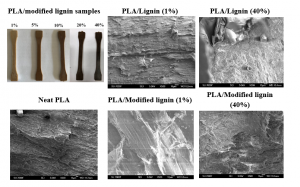The consumption of polymers has increased tremendously over the past few decades; and packaging now utilizes 42 percent of all polymer material worldwide. The extensive usage of polymers affects the environment, including the land and waterways. The high use of polymers in food packaging is due to their convenience over traditional glass and metal packaging.
Polyethylene (PE), polypropylene (PP) and polylactic acid (PLA) are the most commonly used polymers in food packaging. Sustainable and bio-based polymers like PLA are typically more expensive than unsustainable PP and PE-based packaging materials. PLA has the potential to produce more sustainable packaging systems as it is a biopolymer, made from natural resources. It is widely used in plastic films, bottles and biodegradable medical devices. However, due to its poor thermal stability, slow crystallization and high cost, PLA is unsuitable for food storage applications requiring a longer shelf life. The research done at InnoRenew CoE is designed to overcome PLA’s limitations through the incorporation of biopolymers like lignin.
Compatible and biodegradable
Lignin can be obtained as a low-cost byproduct from agricultural and forest biorefineries. It contains several different functional groups (hydroxyl, carbonyl, and carboxyl groups). However, lignin has some compatibility issues with PLA due to the polar functional groups present in this form. Modifying these polar groups within lignin can significantly minimize compatibility issues with the PLA matrix and enhance PLA’s mechanical and physicochemical properties without compromising biodegradability.
The MSCA-PACK-NIN project’s recent work proposes a modification reaction, oxypropylation of lignin hydroxyl groups, to enhance the lignin polymer’s hydrophobicity and plasticity. The researchers produced modified lignin/PLA composites with different weight percentage compositions through a blending and injection moulding process. They examined the thermal degradation properties and glass transition temperature, as well as the cold crystallization and melt temperature of the produced composites. They optimized the weight percentage of modified lignin in the composites, based on the resulting properties. The figure shows the injection-moulded PLA-modified lignin composite specimens and the SEM micrographs of the selected composites after the tensile test of neat PLA, PLA-lignin and PLA-modified lignin.
Future research
To further develop these composites, future research will include additional testing that supports food packaging applications, including antioxidant and degradation studies. The comprehensive results from this study have been submitted for peer-review publication.
Part of the study was conducted at the SUSMATCHEM group, Stockholm University, Sweden, and the MSCA-PACK-NIN project acknowledges the secondment opportunity.
Dissemination
The results were presented at:
– ‘2nd International Conference on Circular Packaging,’ Slovenj Gradec, Slovenia, 9–10 September 2021
– ‘FIRST CIRCUL-A-BILITY CONFERENCE: Re-Thinking Packaging for Circular and Sustainable Food Supply Chains of the Future,’ 26–29 September 2021 (online).
Peer review submission: ‘Characterization of Modified Lignin-PLA Biocomposites for Food Packaging Applications.’
Author
Sudha Esakkimuthu
Source
Supplier
InnoRenew CoE
Stockholm University
Share
Renewable Carbon News – Daily Newsletter
Subscribe to our daily email newsletter – the world's leading newsletter on renewable materials and chemicals














